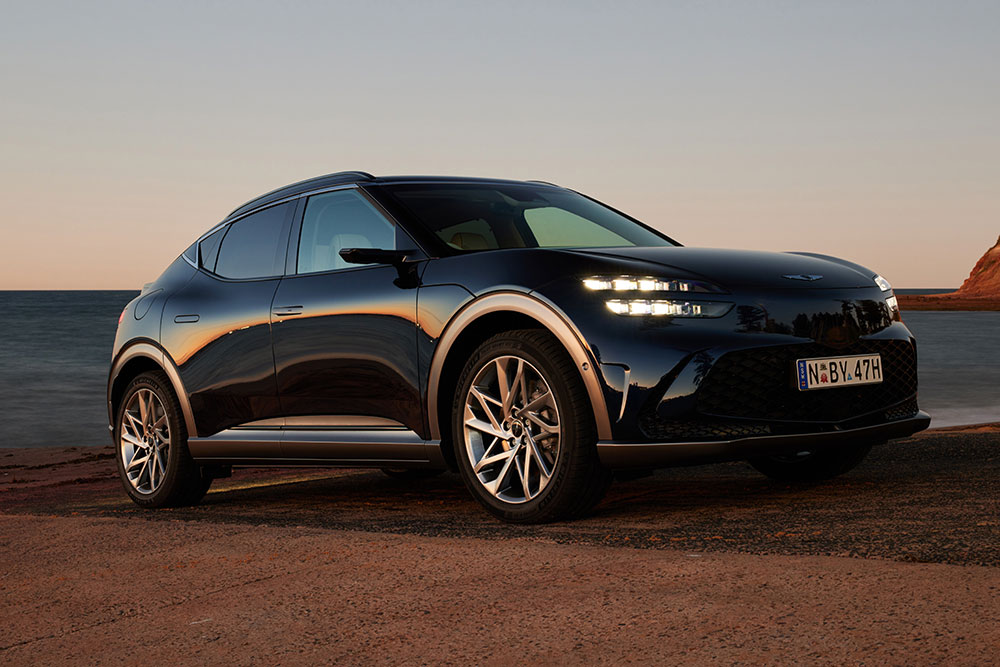Genesis GV60 Luxury AWD EV review
The Genesis GV60 electric car marks the start of a new era for the luxury brand.

The recently arrived Genesis GV60 was the first all-electric model from the Korean luxury car maker and appears to be a harbinger of things to come as the company moves towards an electric future.
The marque followed up the release of the electric-only GV60 with impressive electrified versions of its established G80 saloon and the GV70 medium SUV, which sit alongside their internal combustion engine (ICE) powered siblings.
The trio of new battery electric models are part of the brand’s grand plan to lead its rivals into the age of electrification by focussing on a dual strategy involving hydrogen fuel cell and battery powered EVs.
The GV60 medium SUV is built on a dedicated EV-specific architecture which Genesis dubs E-GMP.
This fact differentiates it from the brand’s other electrified offerings, which are adaptations of existing ICE platforms. Its platform, mechanicals, and other technologies are shared with in-house cousins the Hyundai Ioniq 5 and Kia EV6.
Like other stylish models in the Genesis line-up, the GV60’s striking coupe-like body is a definite head turner, although not everyone agrees it’s for the right reasons.
Bulbous looking from certain angles, its futuristic looks polarised opinions during our week-long test.

It incorporates Genesis signature Crest Grille, albeit lowered and of smaller proportions than others, as well as a distinctive twin-lamp headlight and taillight design.
Offered in two highly equipped variants, both GV60’s come with twin electric-motors and AWD, plus an extensive suite of Genesis Active Safety Control technologies, futuristic features like fingerprint authentication that links to a personalised user profile, and digital mirrors with cameras that replace physical side mirrors.
Prices before on-road costs start at $103,700 for the Luxury model and jump to $110,700 for the more powerful and better equipped Performance variant. That makes the GV60 more affordable than premium electric competitors like the BMW iX3 and the Mercedes Benz EQC, and its in-house rival the GV70 Performance AWD. However, both its Korean EV cousins undercut it considerably with their list prices for AWD versions being in the $78k - $88k range.
Included in the purchase price of every GV60 is the buyer’s choice of a five-year Chargefox subscription or a home AC charger and installation.
The lone option is matte exterior paint at $2,000 and then only on the Performance model, with a choice of three colours including the matte version of Atacama Copper which the company describes as “a unique formulation that feels more like raw copper than conventional matte paints”. There are 10 colours in the normal gloss palette to choose from as well.
Both versions are crammed to the gunwales with goodies to surprise and delight cashed-up owners.
Key points of difference on the flagship version’s equipment list, in addition to its more performance-oriented drive system, include 21-inch alloy wheels (instead of 20s), alloy pedals, metallic interior accents (versus copper on the entry model), black finish on the four-piston monobloc front brake calipers (instead of silver), rear electronically controlled multi-plate limited slip differential, a boost mode which gives a brief increase in motor power and torque, and Road-Preview adaptive electronic control suspension.
A small sampling from the standard features list common to both versions includes:
- Dual-zone climate control
- Digital side mirrors
- 18-way power driver’s seat with massage function
- 12-way power front passenger seat
- Heated and ventilated easy access front seats with relaxation mode
- Heated outer rear seats
- Power tilt/reach steering adjustment
- Remote smart parking
- Heated steering wheel
- Rear privacy glass and sunshades
- Power tailgate
- LED headlights
- Fixed glass sunroof with power sunshade
- Fingerprint authentication
- Active noise control-road system
- Soundproof window and windscreen glass
- 12.3-inch digital instrumentation
- Head-up display.
Also included in the standard equipment list is a V2L (vehicle to load) power-bank function, which allows owners to access a 3.6kW power supply function to charge or operate electronic devices wherever they go.
On the infotainment front tick off a 17-speaker Bang and Olufsen audio system with digital radio, Apple CarPlay and Android Auto, Bluetooth connectivity, 12.3-inch HD multimedia touchscreen, navigation with augmented reality and live traffic, integrated controller with handwriting recognition, three USB-C charging ports and wireless phone charging.
Genesis has also thrown the kitchen sink at the GV60 when it comes to safety and driver assistance technology, with standard features including:
- Eight airbags (including a front centre airbag)
- Blind-spot collision avoidance (side and rear)
- Blind-spot view monitor
- Driver attention warning including lead vehicle departure
- Forward collision avoidance assist (including car/cyclist/pedestrian detection
- Junction turn/crossing function
- Lane-change oncoming/side function
- Evasive steering assist function
- High-beam assist
- Intelligent front lighting
- Intelligent and manual speed limiting
- Lane-keep and lane-following assist
- Front, rear and side parking distance warning
- Reverse parking and rear cross-traffic collision avoidance
- Multi-collision brake
- Rear occupant warning
- Safe exit assist
- 3D surround view monitor
- Trailer stability assist for maximum braked towing capacity up to 1600kg.
The hi-tech Genesis also includes smart cruise control with stop/go function and machine learning – the latter designed to help it learn and match the driver’s driving style.
The cabin has fresh, inviting looks thanks to its minimalist design, luxury finish and design elements such as a floating console, and an infotainment and instrument cluster that merge into a panoramic display unit.
The Crystal Sphere drive selector is a funky looking piece of interior decoration that acts as a mood light when the GV60 is turned off, and changes colour to match the selected drive mode.

In a neat bit of surprise-and-delight gee-whizzery, the sphere rotates in the console to reveal the shift-by-wire gear selector when the vehicle is ready to drive.
Like many EV makers Genesis is also keen on pushing the GV60’s sustainability credentials, noting the use of recycled nylon yarn and recycled PET to manufacture fabrics for the sun visors, headlining and pillar trims. Countering that is the lashings of dead animal skin via the quilted Nappa leather or Nappa leather and suede seats, leather trimmed steering wheel, dashboard, upper door, and centre armrest.
Our test car came finished in Monstera Green and Glacier White with Copper accents, all of which combined to give it a particularly fresh, modern look that enhanced the luxurious and airy feel of the cabin.
My every-practical eye couldn’t help but note that the expanses of white leather trim would likely be devilishly difficult to keep clean.
Fit and finish is to a high standard, as befits the premium pricing and positioning.
A point of difference immediately obvious inside the cabin are the video screens perched on the doors near the base of the ‘A’ pillars.
These display images from a pair of external cameras that replace normal rear vision mirrors.
Power on with RACQ Roadside Assistance for electric carsThe cameras are smaller than a mirror allowing the maker to claim an aerodynamic advantage which aids driving range and the images are said to also be clearer, with reduced blind spots.
However, to say these sci-fi mirrors take some getting used to is quite the understatement.
Being habituated from years of driving to instinctively look to the normal mirror location for rearward views, rather than an inboard screen, is difficult behaviour to undo.
And despite the maker’s claims that the image on the screen is superior, we found judging the position of following vehicles on a dark, drizzly night more difficult than with normal mirrors.
The increased level of headlight flare had us questioning the need for this technology.
More welcome is the rear and surround view monitor, as well as park distance warnings, which all do their job admirably, particularly given the design of the rear bodywork which tends to compromise rearward vision.
The dedicated EV platform enables a flat floor which frees up some cabin space, as does the slim design of the front seatbacks, allowing for improved rear passenger leg room. Foot space in the rear row is still a little tight, though, and taller passengers may find the roof height is an issue.
Cargo space is a useful 432 litres (VDA), expanding to 1,460 litres when the 60:40 split rear seat is folded flat.
That’s a little smaller than the rival BMW iX3 which claims 510 litres and 1,560 litres, respectively.
Powering the GV60 Luxury is a pair of permanent magnet synchronous electric motors, the front rated at 74kW and the rear at 160kW, for a total of 234kW and maximum torque of 605Nm.
Performance is strong from the get-go with plentiful torque and an ability to shove you back in your seat.

The GV60 keeps on delivering as speed rises, offering solid roll-on acceleration.
The manufacturer claims a tidy 5.5 second 0-100km/h sprint meaning both peak outputs and acceleration performance outgun BMW’s iX3.
For drivers seeking something more potent, the Performance variant offers a 10-second boost mode that briefly ups the outputs of its twin motors to 180kW, for a total output of 360kW, while torque peaks at 700Nm.
That compares with ‘normal’ outputs of 160kW from each motor for a total of 320kW and 605Nm.
Acceleration from rest to 100km/h is a sprightly 4.6 seconds in normal mode, or an attention grabbing 4.0 seconds in boost mode.
Out on the road, the GV60 Luxury proves smooth and refined, offering a blend of plush ride and competent secure roadholding.
It lacks the sportier edge of BMW’s finely honed iX3, but most buyers are likely to be satisfied.
Both GV60 variants feature a 77.4kW/h lithium-ion battery pack providing a fully charged range of 470km (WLTP) for the Luxury and 466km (WLTP) for the Performance version.
The level of regenerative braking is driver adjustable via steering wheel mounted paddle shifters, but if you’d prefer to let the computer handle it the car’s Smart Regenerative Braking 2.0 system can intelligently optimise regen braking in three stages, based on parameters including speed limit, mapping data, and vehicle speed.
The GV60 uses a 400/800-volt charging strategy to enable stable rapid charging on various charging infrastructures, as well as a battery conditioning function to maintain the battery at its optimal temperature.
In colder climates this function can preheat the battery when ambient temperatures are low to ensure better performance and reduced charge time.
The maker quotes a charge time of 34 hours and 20 minutes from 10% to 100% charge when using a standard domestic 10amp outlet.
That reduces to around 73 minutes on a 50kW fast charger and 18 minutes on a 350kW ultra-fast charger.
A five-year/unlimited-kilometre warranty covers the vehicle, with the high-voltage battery warranted for eight years.
Other owner benefits include five years of complimentary servicing, five years Genesis to You and Valet service, as well as 24/7 roadside assistance and complimentary map updates, both for 10 years.
If that isn’t enough to go on with, the GV60 has recently been awarded gold in the 2022 Australian Good Design awards for its outstanding design and innovation as well as a Special Accolade for its interior design.
Key stats
- MLP: $103,700
- ENGINE: Front and rear permanent magnet synchronous electric motors
- ANCAP CRASH RATING: 5 stars (2022)
- ENERGY CONSUMPTION (WLTP Test Cycle, kWh/100km): 18.8 (0 g/km tailpipe CO₂)
- FOR: Comfort and refinement, performance, equipment and safety features, decent range, luxury finish and interior styling, plenty of tech.
- AGAINST: Mobility kit – no spare, rear space limitations, body design compromises rear visibility, polarising exterior styling, camera-based exterior ‘mirrors’.
Related topics
Things to note
The information in this article has been prepared for general information purposes only and is not intended as legal advice or specific advice to any particular person. Any advice contained in the document is general advice, not intended as legal advice or professional advice and does not take into account any person’s particular circumstances. Before acting on anything based on this advice you should consider its appropriateness to you, having regard to your objectives and needs.
Insurance Products (excluding Travel Insurance) are issued by RACQ Insurance Limited ABN 50 009 704 152 (RACQI) and arranged by its agent, RACQ Distribution Services Pty Ltd (RDS) ABN 35 116 361 650, AFSL 567130 and RDS' authorised representatives (including RACQ Operations Pty Ltd ABN 80 009 663 414, AR No. 234978 (RACQO). Conditions, limits and exclusions apply. RDS and RACQO are in the RACQ group of companies. One of the companies in the RACQ group of companies has a minority shareholding in RACQI.
RDS and RACQO have not taken your personal objectives, circumstances or needs into account when preparing advice regarding insurance products and you will need to consider whether the advice is appropriate for you. Read the Product Disclosure Statement (PDS) and any applicable Supplementary PDS before making a purchase decision on this product. You can also access our Target Market Determinations on this website. RDS receives a commission from RACQI for the policies it arranges. RACQO receives fees paid for services it provides to RDS. Further details about remuneration are available on request prior to purchasing.
Banking and loan products issued by Members Banking Group Limited ABN 83 087 651 054 AFSL/Australian credit licence 241195 trading as RACQ Bank. Terms, conditions, fees, charges and lending policies apply. This is general advice only and may not be right for you. This information does not take your personal objectives, circumstances or needs into account. Read the disclosure documents for your selected product or service, including the Financial Services Guide and the Terms and Conditions, and consider if appropriate for you before deciding.
Except for RACQ Bank, any RACQ entity referred to on this page is not an authorised deposit-taking institution for the purposes of the Banking Act 1959 (Cth). That entity’s obligations do not represent deposits or other liabilities of RACQ Bank. RACQ Bank does not guarantee or otherwise provide assurance in respect of the obligations of that entity, unless noted otherwise.
RACQ Bank subscribes to the Customer Owned Banking Code of Practice which establishes higher standards than the law requires. The Code reflects modern consumer expectations and developments in approaches to issues such as consumer vulnerability, guarantors, and supporting customers through financial hardship. Please read our Customer Owned Banking Code of Practice page for more information.
RACQ Operations Pty Ltd (ABN 80 009 663 414 AR 000234978) and Members Travel Group Pty Ltd (ABN 45 144 538 803 AR 000432492) are acting as an Authorised Representative of the issuer of the insurance, Tokio Marine & Nichido Fire Insurance Co., Ltd. (ABN 80 000 438 291 AFSL 246 548). Any advice set out above is general in nature only, and does not take into account your objectives, financial situation or needs. Before purchasing any travel products, please consider the RACQ Travel Insurance Product Disclosure Statement (PDS) and the Target Market Determinations (TMDs) that apply to these products. Whilst the PDS outlines the Terms and Conditions of these products, the TMDs outline the intended class of customers that comprise the target market for these travel products. This will allow you to consider which products best suit your objectives, financial situation and needs and consider the products appropriateness to your personal circumstances. TMDs also outline matters involving the distribution and the review of these products. The PDS, Supplementary PDS and TMDs for each travel product can be found here.

